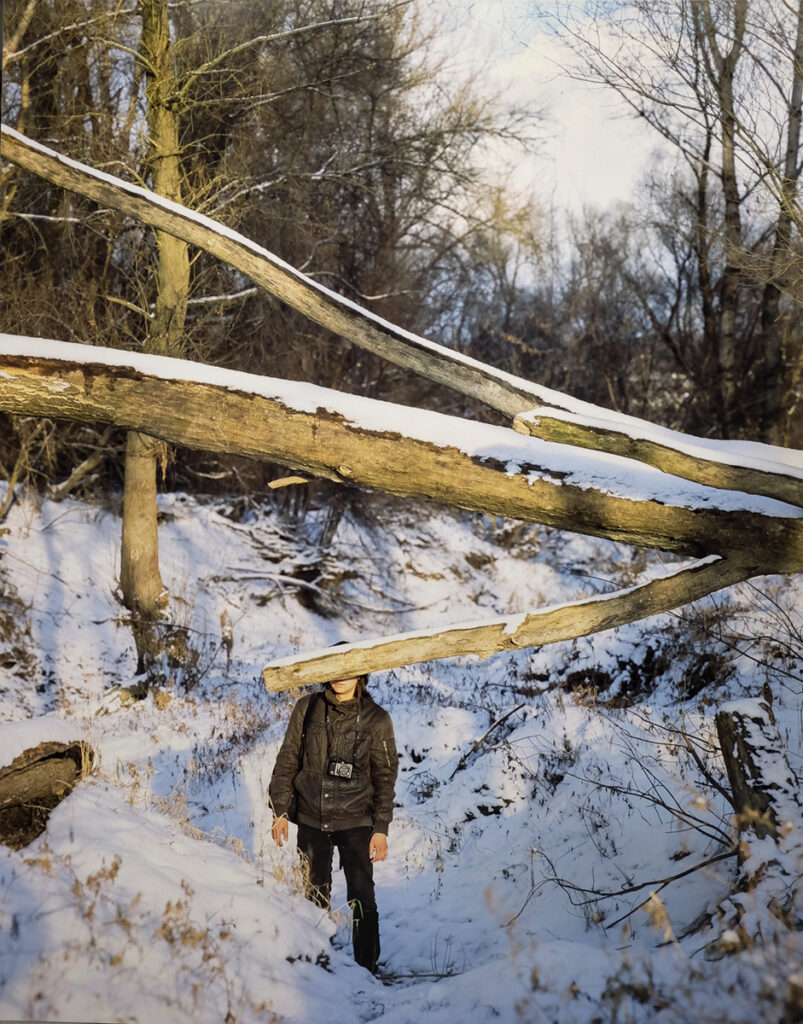Ján Kekeli is a photographer who follows principles based on an intersection of documentary and art photography. His work focuses on landscape (projects like Landscape Images, Talking Stone, Visual Changes), but lately he has been working more and more on still lifes. These images tend to capture everyday objects arranged in random or predetermined compositions. They rely on small, subtle narrative blocks whose purpose is to create a fictional script prepared by the artist for the viewers whose interpretation then turns it into a play. This process of dramatisation is also referred to in some of his former exhibition projects (Small Stage, Vague Script). He often captures trivial objects and situations which tend to require new interpretation models. In this way, he draws the viewer’s attention to the visual qualities of objects that surround us in our everyday life. Kekeli works with large-format analogue photography which shows off the artist’s technical skills. It is apparent from the balanced colour schemes, sharpness of the photographs and also the precisely built compositions. It is usually almost exclusively symmetric, always arranged in multiple layouts which tend to either isolate or cluster different objects. This kind of approach tends to bring Kekeli’s work closer and closer to fine art photography. He often intensifies the suggestiveness of his works once they are installed in the gallery space by positioning them in different view angles, on the floor, in relation to other objects (windows, shelves, doors) or simply incorporating the expressiveness of an empty space. In a broader context, Kekeli’s work could be categorised as pictorial photography, which started evolving overseas in the early 1980s and peaked around 2001.1
A large part of the artist’s portfolio features landscapes. As he claims himself, he is often inspired by older art genres, mostly 19th-century landscape paintings. In this regard, he refers to the painter Caspar David Friedrichand photographers Karol Divald and Jindřich Eckert. Kekeli usually depicts Slovak landscape, ranging from mountain regions to urban territories. Due to the extreme levels of intimacy and monumentality purposefully incorporated into the landscape cut-outs, the viewer often actually feels like they are there themselves. The works are also deliberately designed to evoke feelings of melancholy, anxiety, fulfilment and exhaustion. A large number of pictures from the Landscape Images project is presented in the form of diptychs (two individual pictures forming one unit) with each of the two often representing the opposing extremes of landscape contexts. They may feature romantic themes, such as untouched nature, random groups of people, ruins or lonely figures staring into the landscape.
Our Untitled photograph from 2015 could be assigned to this category. The large-scale photograph features a figure in snow-covered woods with a camera hanging from their neck and face hidden behind a branch of a fallen tree. It is unclear if the person is the artist himself or if it is simply someone else being captured by the artist. In any case, the figure evokes someone in the middle of a romantic landscape, staring into the silence. However, there are different levels of interpretation possible. If we think about the image in the context it is usually presented in (meaning with the central part of the image positioned at the viewer’s eye level), the viewer standing in front of the image is also staring into the landscape. The top-down view of the photograph positions them into the realm of the romantic heroes of typical 19th-century images. The landscape might have arranged for this unexpected meeting of a person whose face is hidden so they cannot get to know each other nor read into each other’s eyes or facial expressions. In spite of that, the viewer is followed by another eye, the camera, inconspicuously pointed toward them. The person in the photograph and the viewer thus form an unexpectedly uneven relationship where one of them is being watched. But a question remains whether the person in the photograph is the artist himself, capturing himself in his own image with an attribute typical for his job. In this case, this could be a self-portrait emphasising his position on the moment of loneliness in the landscape, evoking abandonment, typical for a romantic way of thinking. This kind of interpretation could be also directed at the dead fallen tree, a version of a ruin from a 19th-century painting.
Ján Kekeli (*1984, Kežmarok) studied at AFAD at the Studio of Photography led by Filip Vančo (2006-2012) and later, as a part of his doctoral studies, he spent some time at a studio led by Ľubo Stacho at AFAD. In 2009, he went on a study trip to Poland where he studied at Uniwersytet Artystyczny in Poznań. He has participated at dozens of solo and group exhibitions both in Slovakia and abroad. In 2012, he was a finalist of the Startpointprize award and winner of the VÚB Foundation Photograph of the Year award. In 2013, he was a finalist of the ESSLART award for young artists and in 2016, he won the scholarship of the Novum Foundation, a foundation for new art. Ján Kekeli’s work is a part of various private and public collections. He currently lives and works in Bratislava.
— Adrián Kobetič, April 2020
Sources
1 FOSTER, Hal. Umění po roce 1900. Praha: Slovart, 2007. p. 659 – 663.
Inventory No.: F 157
Artist: Ján Kekeli
Title: Untitled
Year of origin: 2015
Technique: C-print
Material: dibond
Dimensions: 190 × 150 cm
Signature: none
The acquisition was supported using public funds provided by the Slovak Arts Council in 2019.
